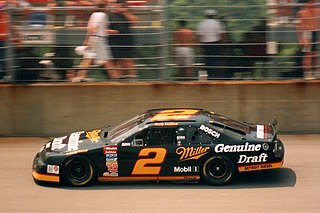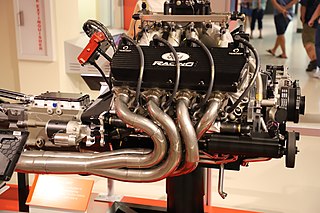
Talladega Superspeedway, nicknamed "Dega", and formerly named Alabama International Motor Speedway (AIMS) from 1969 to 1989, is a motorsports complex located in Lincoln, Alabama, north of Talladega, Alabama. It is located on the former Anniston Air Force Base. A tri-oval, the track was constructed in 1969 by the International Speedway Corporation, a business controlled by the France Family. As of 2023, the track hosts the NASCAR Cup Series, NASCAR Xfinity Series, NASCAR Craftsman Truck Series, and ARCA Menards Series. Talladega is the longest NASCAR oval, with a length of 2.660 mi (4.281 km), compared to the Daytona International Speedway, which is 2.500 mi (4.023 km) long. The total peak capacity of Talladega is around 175,000 spectators, with the main grandstand capacity being about 80,000. As of 2023, Talladega is one of NASCAR's three drafting tracks, alongside Daytona International Speedway and Atlanta Motor Speedway.

A restrictor plate or air restrictor is a device installed at the intake of an engine to limit its power. This kind of system is occasionally used in road vehicles for insurance purposes, but mainly in automobile racing, to limit top speed to provide equal level of competition, and to lower costs; insurance purposes have also factored in for motorsports.

Drafting or slipstreaming is an aerodynamic technique where two moving objects are aligning in a close group to exploit the lead object's slipstream and thus reduce the overall effect of drag. Especially when high speeds are involved, as in motor racing and cycling, drafting can significantly reduce the paceline's average energy expenditure and can even slightly reduce the energy expenditure of the lead vehicle.

A spoiler is an automotive aerodynamic device whose intended design function is to 'spoil' unfavorable air movement across the body of a vehicle in motion, usually manifested as lift, turbulence, or drag. Spoilers on the front of a vehicle are often called air dams. Spoilers are often fitted to race and high-performance sports cars, although they have become common on passenger vehicles as well. Spoilers are added to cars primarily for styling purposes and either have little aerodynamic benefit or even worsen the aerodynamics.

The Car of Tomorrow was the common name used for the chassis of the NASCAR Cup Series and Xfinity Series race cars. The car was part of a five-year project to create a safer vehicle following several deaths in competition, particularly the crash at the 2001 Daytona 500 that killed Dale Earnhardt.

The 2009 Aaron's 499 was the ninth race of the 2009 NASCAR Sprint Cup season. With a distance of 500.8 miles (806.0 km), it was held on April 26, 2009 at the 2.66 miles (4.28 km) Talladega Superspeedway in Talladega, Alabama. Fox Sports broadcast the race starting at 1 PM EDT, with MRN and Sirius XM Radio carrying the radio broadcast over the air and on satellite respectively. The race had nine cautions, 25 different leaders, and 57 lead changes, the most lead changes of the season up until that point.

Safety in NASCAR has evolved into one of the biggest concerns in stock car racing's largest sanctioning body. Mainly after the death of Dale Earnhardt, a seven-time Winston Cup Series champion, NASCAR has decided to change all of their safety policies, such as the use of the HANS device. Since 2001, NASCAR has also changed the cars for the NASCAR Cup Series and the Xfinity Series. NASCAR's safety policy includes the racing fire suit, carbon fiber seating, and roof flaps.

The 1985 Winston 500 was a NASCAR Winston Cup Series racing event that took place on May 5, 1985, at Alabama International Motor Speedway in Talladega, Alabama as race number 9 of 28 of the 1985 NASCAR Winston Cup Series season.

The 1987 Winston 500 was the ninth stock car race of the 1987 NASCAR Winston Cup Series season and the 18th iteration of the event. The race was held on Sunday, May 3, 1987, before an audience of 135,000 in Lincoln, Alabama at Alabama International Motor Speedway, a 2.66 miles (4.28 km) permanent triangle-shaped superspeedway. The race was shortened from its scheduled 188 laps to 178 due to impending darkness that was caused by a lengthy red flag for debris cleanup and catch fence repairs for an earlier accident.

The 1977 Winston 500 was a NASCAR Winston Cup Series race that took place on May 1, 1977, at Alabama International Motor Speedway in Talladega, Alabama. The tenth of 30 races of the 1977 Winston Cup Grand National season, the Winston 500 started 41 cars.

The 1974 Winston 500 was a NASCAR Winston Cup Series racing event that was held on May 5, 1974, at Alabama International Motor Speedway in Talladega, Alabama.

The 2015 GEICO 500 was a NASCAR Sprint Cup Series race held on May 3, 2015 at Talladega Superspeedway in Lincoln, Alabama. Contested over 188 laps on the 2.66 mile (4.28 km) asphalt superspeedway, it was the tenth race of the 2015 NASCAR Sprint Cup season. Dale Earnhardt Jr. won the race, his first win of the season and his sixth at Talladega Superspeedway and first at the racetrack since 2004. His teammate Jimmie Johnson finished second, while Paul Menard, Ryan Blaney and Martin Truex Jr. rounded out the Top five.

The 2018 GEICO 500 was a Monster Energy NASCAR Cup Series race held on April 29, 2018, at Talladega Superspeedway in Lincoln, Alabama. Contested over 188 laps on the 2.66 mile (4.28 km) superspeedway, it was the 10th race of the 2018 Monster Energy NASCAR Cup Series season.

The 2019 MoneyLion 300 was a NASCAR Xfinity Series race held on April 27, 2019, at Talladega Superspeedway in Lincoln, Alabama. Contested over 113 laps on the 2.66 mile (4.28 km) superspeedway, it was the ninth race of the 2019 NASCAR Xfinity Series season. This was the season's third Dash 4 Cash race.

The 2019 Sugarlands Shine 250 is a NASCAR Gander Outdoors Truck Series race held on October 12, 2019, at Talladega Superspeedway in Lincoln, Alabama. Contested over 94 laps on the 2.66 mile (4.28 km) superspeedway, it was the 20th race of the 2019 NASCAR Gander Outdoors Truck Series season, fourth race of the Playoffs, and first race of the Round of 6.

The 1993 DieHard 500 was the 18th stock car race of the 1993 NASCAR Winston Cup Series season and the 25th iteration of the event. The race was held on Sunday, May 2, 1993, before an audience of 100,000 in Lincoln, Alabama at Talladega Superspeedway, a 2.66 miles permanent triangle-shaped superspeedway. The race took the scheduled 188 laps to complete. In one of the closest finishes in NASCAR Winston Cup Series history, Richard Childress Racing driver Dale Earnhardt would manage to best out a last-lap challenge against Morgan–McClure Motorsports driver Ernie Irvan by 0.005 seconds at the finish line, with Earnhardt managing to extend his dominant driver's championship lead over the rest of the field with the victory. The victory was Earnhardt's 59th career NASCAR Winston Cup Series victory and his sixth and final victory of the season. To fill out the top three, Roush Racing driver Mark Martin would finish third.

The 2021 GEICO 500 was a NASCAR Cup Series race was held on April 25, 2021, at Talladega Superspeedway in Lincoln, Alabama. Contested over 191 laps – extended from 188 laps due to an overtime finish, on the 2.66 mile (4.28 km) superspeedway, it was the 10th race of the 2021 NASCAR Cup Series season, as well as the second of the four crown jewel races. Brad Keselowski won the race, his 35th career victory, sixth win at Talladega, and his last win with Team Penske in the No. 2 as he moved to Roush Fenway Keselowski Racing in 2022.

The Generation 4 car was the NASCAR vehicle generation used from 1992 to 2007 full-time in the NASCAR Cup Series, in the Busch/Nationwide Series until 2010, and in the ARCA Racing Series until 2017. The generation has been described as the generation that removed all "stock" aspects from stock car racing and was as aerodynamically sensitive as a Le Mans Prototype.

NASCAR, the highest governing body and top level division for stock car racing in the United States, has used a range of different types of engine configurations and displacements since its inaugural season in 1949. The engines are currently used in the Cup Series, Xfinity Series, Camping World Truck Series, and the Whelen Modified Tour.

The 2022 General Tire 200 was the third stock car race of the 2022 ARCA Menards Series season, and the 60th iteration of the event. The race was held on Saturday, April 23, 2022, in Lincoln, Alabama at Talladega Superspeedway, a 2.66 mile permanent triangle-shaped superspeedway. The race was decreased from 76 laps to 68 laps, due to a time restraint with the NASCAR Xfinity Series race. At race's end, Nick Sanchez of Rev Racing would win, after Daniel Dye spun on the backstretch with 9 laps to go. This was Sanchez's second career ARCA Menards Series win, and his first of the season. To fill out the podium, Bret Holmes of Bret Holmes Racing and Corey Heim of Venturini Motorsports would finish 2nd and 3rd, respectively.














